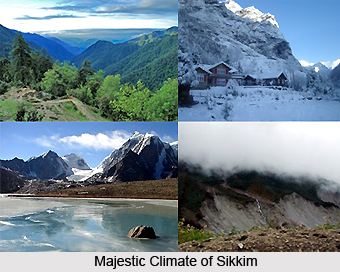Though Sikkim is a small town, it has all the possible climate right from the tropical to the tundras. So much so, it is possible to drop from the arctic heights to the tropical lowlands within a matter of a couple of hours. On most parts of the northern, eastern and western borders the earth is blanketed with snow almost throughout the year because of high altitudes. Elevations of 6000 metres i.e. 19900 ft and above remain snowbound throughout the year whereas places as low as 3000 metres i.e. 9840 ft come within the snowline during the winters. In the southern border there can be found altitudes plummeting down to as low as sea level and also full of rich tropical forests. Even the climate on two opposite sides of a hill can vary considerably.
Temperatures
The temperatures that a particular place experiences varies considerably with altitude. At places of low altitude, like Singtam, Rangpo and Jorethang, the temperatures vary between 4 °C to 35 °C. Whereas in the places like Gangtok with moderate altitudes of about 1800 metres i.e. 6000ft experience temperatures between 1 °C and 25 °C. It can also be seen that at altitudes above 4000 metres i.e. 13100 ft, the temperature never rises above 15 °C and remains much below the freezing point during the winters and great part of the spring and autumn as well.
Rainfall
 Sikkim is one of the rainiest regions in India. Most parts of the place experience torrential rains during summers. This happens because of the fact that the proximity of Sikkim to the Bay of Bengal and also the mountains of the state come directly in the path of the monsoon clouds,. So much so that even a small depression over the Bay of Bengal triggers off a downpour in Sikkim. Even during spring and autumn moisture laden clouds formed due to local evaporation. And these eventually continue to batter a greater part of Sikkim. It is only during October to March that there is hardly any rain and the weather remains more or less clear.
Sikkim is one of the rainiest regions in India. Most parts of the place experience torrential rains during summers. This happens because of the fact that the proximity of Sikkim to the Bay of Bengal and also the mountains of the state come directly in the path of the monsoon clouds,. So much so that even a small depression over the Bay of Bengal triggers off a downpour in Sikkim. Even during spring and autumn moisture laden clouds formed due to local evaporation. And these eventually continue to batter a greater part of Sikkim. It is only during October to March that there is hardly any rain and the weather remains more or less clear.
Rainfall however varies considerably from place to place because of the hill features. The northern border of Sikkim experiences comparatively low rainfall because the monsoon clouds dry out by the time they hit the northern barrier. For the sake of comparison, Gangtok registers an average of 325 cm rainfall per annum whereas Muguthang in the extreme north experiences an average rainfall of only 60 cm per annum. Most of Sikkim does not experience high intensity winds. However, at many hill tops and passes, winds and blizzards having considerably high speeds.
The rainfall would decrease at higher altitudes and so would the maximum-minimum temperature. Because of high humidity in this region, even a temperature of 30 C is considered to be uncomfortably hot.






